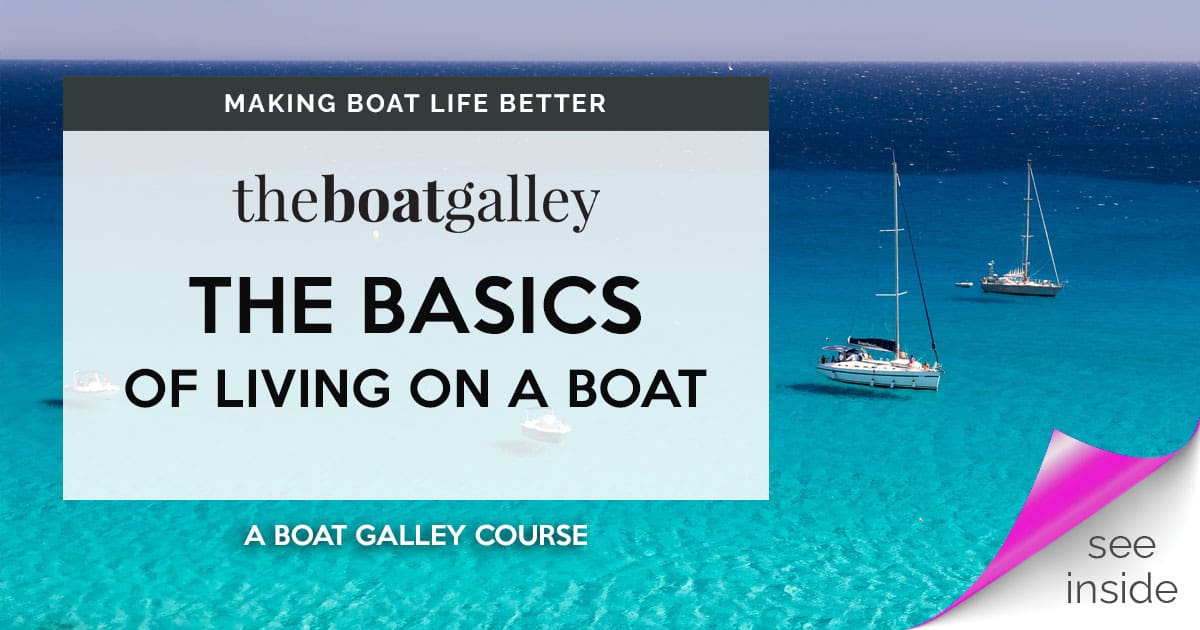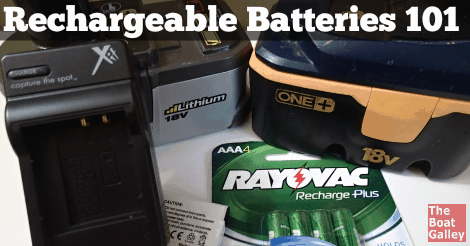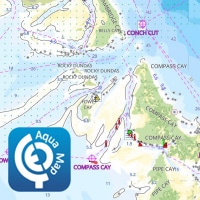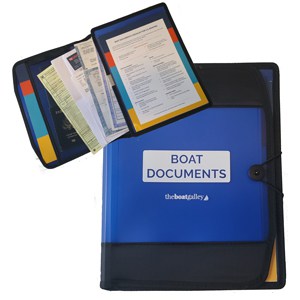We use rechargeable batteries in all sorts of things every day — power tools, solar lights, solar fans, flashlights, my camera, our tablets, some kitchen appliances, and more. Basically, anything that’s “cordless” and powered. Heck — even my toothbrush has a rechargeable battery!
NOTE: In this post, I’m discussing batteries that are in various consumer devices, not the main house or starting batteries for the boat.
Rechargeable battery technology has changed tremendously in the past 10 or so years and we’ve learned to look carefully at what’s “inside” various items as we decide what to buy, as well when we buy replacement batteries. Four primary factors play a role in how long a battery will last — both for use today and how soon you’ll have to replace it. Below is a summary of these factors at what I’ll call a “101” level — it’s not an exhaustive look at every aspect of rechargeable batteries, but hits the important things to know.
I’m not an “expert” on rechargeable batteries; it’s just that we’ve learned a lot about them over the years . . . and a certain amount of that learning has been by doing the wrong thing and then figuring out why it was wrong.
Whether you’re talking about a AA, AAA, C, or D cell battery, or a specialized battery pack for a particular item, or even a non-replaceable built-in battery, the same considerations apply.
Type of Battery
Rechargeable batteries are one of three technologies: nickel-cadmium (generally shorted to NiCad); nickel metal hydride (usually referred to as “metal hydride” and abbreviated as NiMH) and lithium-ion (usually just called “lithium” and abbreviated as Li or Li-ion).
The battery technology determines three important characteristics of the battery:
- Memory. Without going into a long technical discussion, “memory” refers to the fact that some battery technologies won’t fully charge a battery if the battery is only partially depleted before being recharged. If a battery is subject to memory, you should fully discharge the battery before recharging it. Most people prefer to recharge a battery when it’s convenient (say between uses) than getting halfway through a project and needing to recharge.
NiCads have the biggest problem with memory (and they can be damaged by discharging them too far, making it very difficult to know exactly when they should be charged for the longest life). Metal hydrides have less of a problem with memory and it’s generally considered okay to recharge them at any time. Lithium batteries have no memory issues.
- Self-Discharge. Self-discharge refers to the rate at which batteries lose their charge when stored with no load on them. Metal hydrides have the fastest rate of self-discharge, at about 1% a day — meaning that in a month without use, they’ll be down 30%. Consequently, never use NiMH batteries for things such as smoke detectors as there may not be any charge left by the time it’s needed.
NiCads have about half the self-discharge of NiMH, or about 15% a month. Lithium have the lowest rate of self-discharge, at about 10% a month. (NOTE: lithium batteries that are not rechargeable employ various technologies to reduce the self-discharge further, making them suitable for EPIRBs, emergency flashers and more).
Being stored at higher temperatures will make the self-discharge problem worse; lithium batteries in particular do not like heat (keeping them in a hot location is about the quickest way to destroy them). Both NiCads and Li have bigger problems with self discharge when fully charged; thus they should be discharged about halfway before being stored.
- Rate of Charge/Discharge. NiCads can take a fast charge and fast discharge, while Li and NiMH do better with slower charging. Both NiCad and Li are good in applications such as power tools that don’t tolerate a voltage drop well (that is, you want your cordless drill or vacuum to have full power when you use it, even if the battery is partially discharged). Metal hydrides are better in high-drain devices such as most electronics.
Battery Capacity
While designations such as “AA” or “D” refer to a battery size and voltage, different brands/models will vary by battery capacity, which is expressed in amp-hours or, for small batteries, milli-amp-hours (mAH or mAh). Bigger numbers mean that you go longer before recharges, and bigger will likely have a longer useful life as it will still provide sufficient power even as it loses some capacity due to age.
Other Factors
- Lithium batteries typically weight 20 to 35% less than comparable NiCad or NiMH batteries. For power tools, this can be a deciding factor!
- Li and NiMH batteries are much more environmentally friendly when they reach the end of their useful life: NiCads contain cadmium, a very toxic heavy metal.
- Lithium rechargeables cost about 3 times as much as NiCads and NiMHs.
- Always check to make sure that the batteries you are buying are compatible with the charger you’ll be using — the wrong one can harm the battery, not provide a charge or, in rare instances, cause a battery to explode.
Over and over, I read that heat is the biggest enemy of batteries. While you can’t change the weather, at least try to store your batteries in the coolest possible location. If you store your boat in a hot climate for the summer, consider taking anything with batteries home with you. I know, it’s not always possible. But if you leave them in a hot boat, realize that you cannot expect “normal” life from them.
Running a Charger on an Inverter
One last thing about rechargeable batteries, and it’s important. If you run the chargers off an inverter (as opposed to a 12-volt charger running off a cigarette lighter plug), it’s much, much better to have a pure sine wave inverter. Using a modified sine wave inverter can both damage the charger and poorly charge the batteries.
We totally destroyed the charger for a nice set of power tools the first time we tried to use it on a modified sine wave inverter, a very expensive lesson made even worse by the fact that we couldn’t get a replacement for nearly three months. Read more about pure sine wave inverters vs. modified sine wave inverters.
Pure sine wave inverters used to be frightfully expensive but have come down in price considerably in the past 10 years. If you’re in the market for an inverter, I’d spend the extra for a pure sine wave as not just battery chargers, but all electronics and variable speed motors will run much better on it.

Carolyn Shearlock has lived aboard full-time for 17 years, splitting her time between a Tayana 37 monohull and a Gemini 105 catamaran. She’s cruised over 14,000 miles, from Pacific Mexico and Central America to Florida and the Bahamas, gaining firsthand experience with the joys and challenges of life on the water.
Through The Boat Galley, Carolyn has helped thousands of people explore, prepare for, and enjoy life afloat. She shares her expertise as an instructor at Cruisers University, in leading boating publications, and through her bestselling book, The Boat Galley Cookbook. She is passionate about helping others embark on their liveaboard journey—making life on the water simpler, safer, and more enjoyable.
Here’s your “Quick Start” to everything you need to know when living on a boat:










Mark and Cindy - s/v Cream Puff says
We purchased a whole bunch of Sanyo NiMH Eneloop brand batteries. We spent a small fortune thinking we were doing our bit to help the environment and have the added convenience of never needing a battery. Big mistake! The batteries lasted less than one year. After which they would not hold a charge. I would estimate we were only able to recharge the batteries about 4 times before they became useless. For the most part, we used the AAA in LED flashlights (we use when working on projects or night watch etc.) or devices such as smoke and CO detectors, iPod speakers etc. Even the LED flashlights drained the battery within 15 minutes. Regular batteries lasted over 15 hours in the flashlight.
We used the compatible charger that came with the batteries and we do have a pure sine wave inverter.
We converted our CO and smoke detectors back to regular batteries as we felt we couldn’t trust the rechargeables with vital equipment. We have since gone back to purchasing bulk packs at Costco or Wal-Mart. We have had much better luck with regular one time use batteries.
I hope others have had better experiences than us. I would love to hear other viewpoints here as perhaps we just selected the wrong brand for the marine environment.
Mark and Cindy
s/v Cream Puff
http://www.creampuff.us
Monique says
Hey Mark & Cindy,
Wow, I find your experience remarkable and wonder if you contacted the company…perhaps you somehow purchased a batch of defective batteries? We have an large collection of Eneloop batteries (both AA and AAA) which we use in a range of items on board and find their quality unsurpassed. They get heavy use, seem to last forever, and hold their charge.
I know your comment was some time ago, but hope you were able to resolve your issue with the batteries.
Cheers,
Monique
s/v Paragon